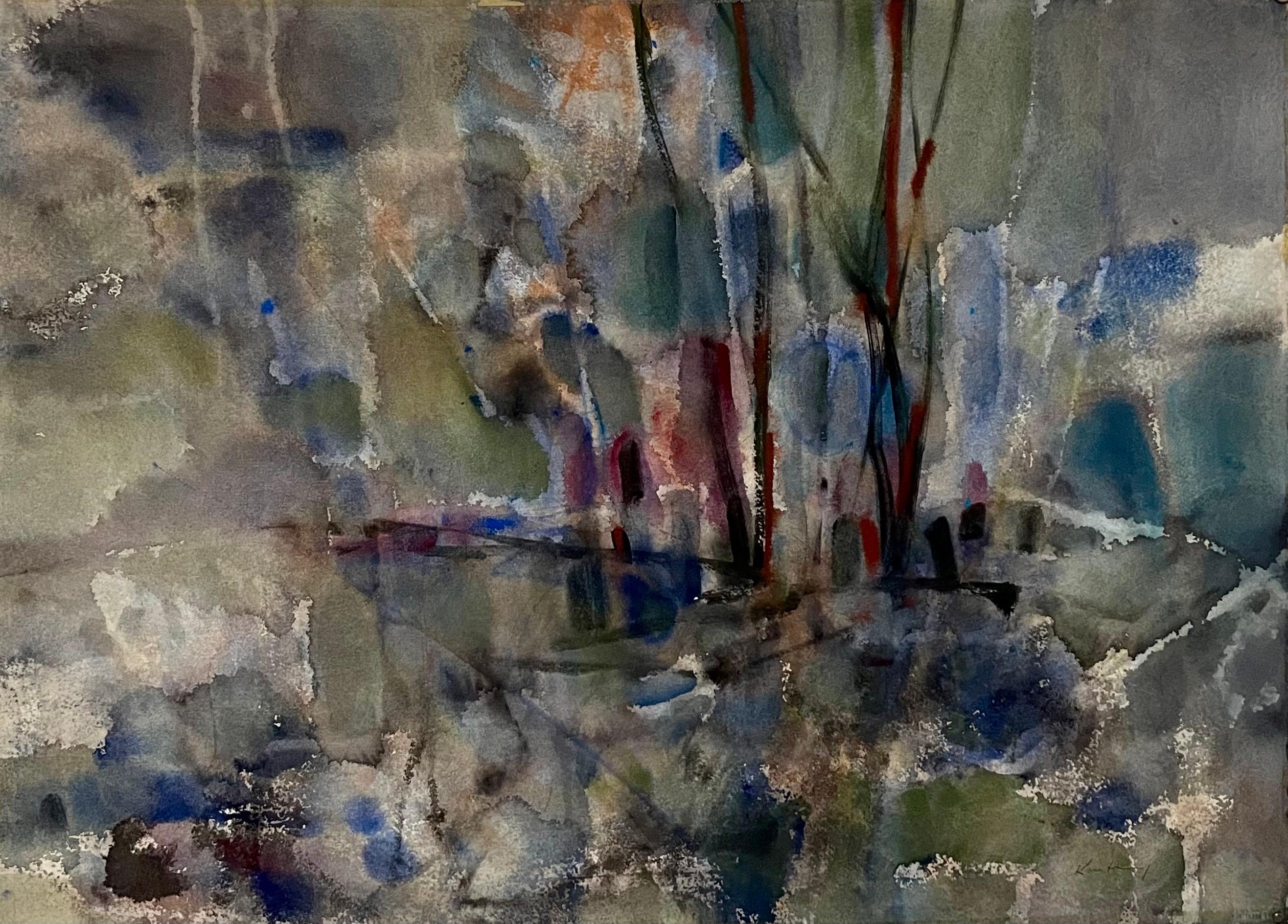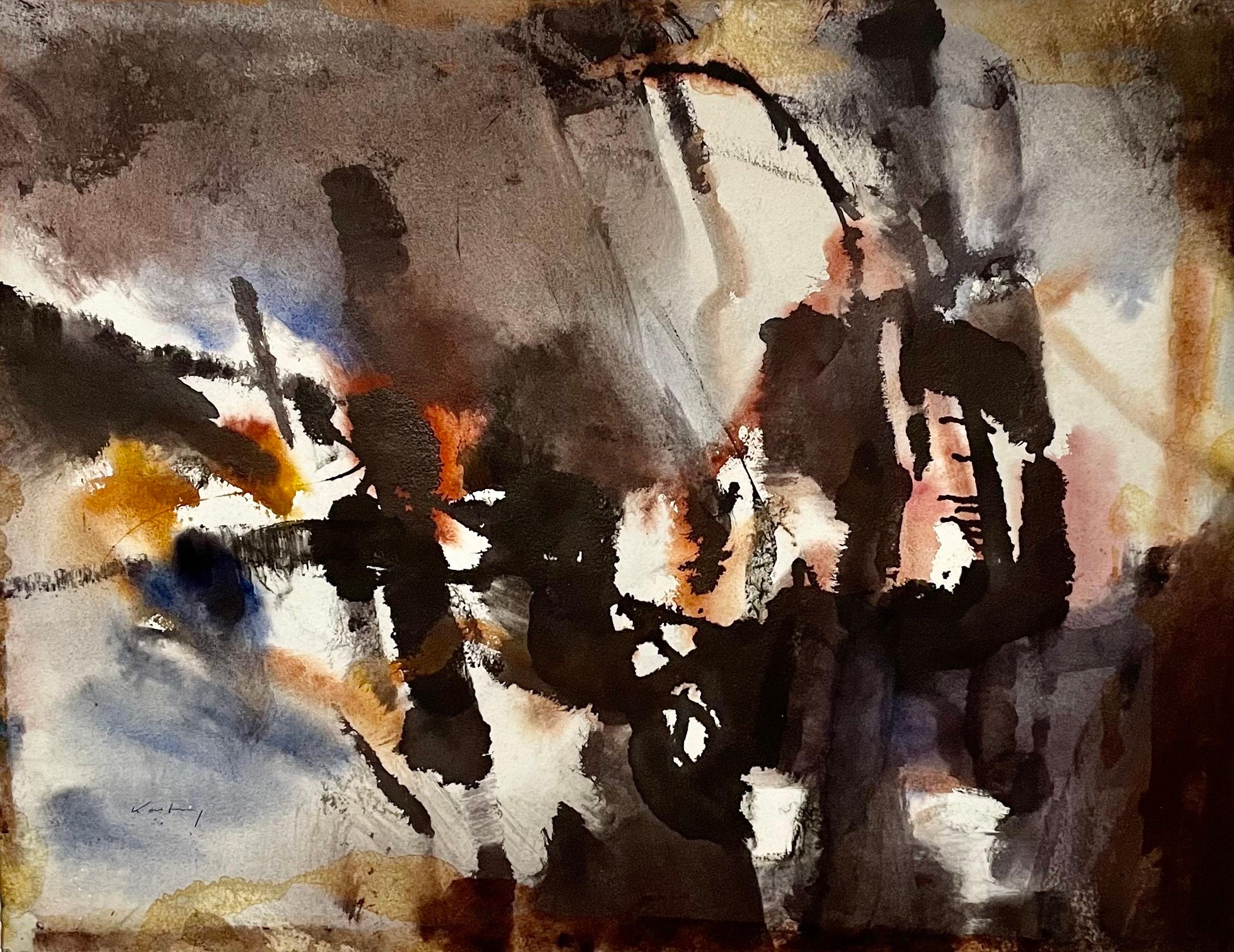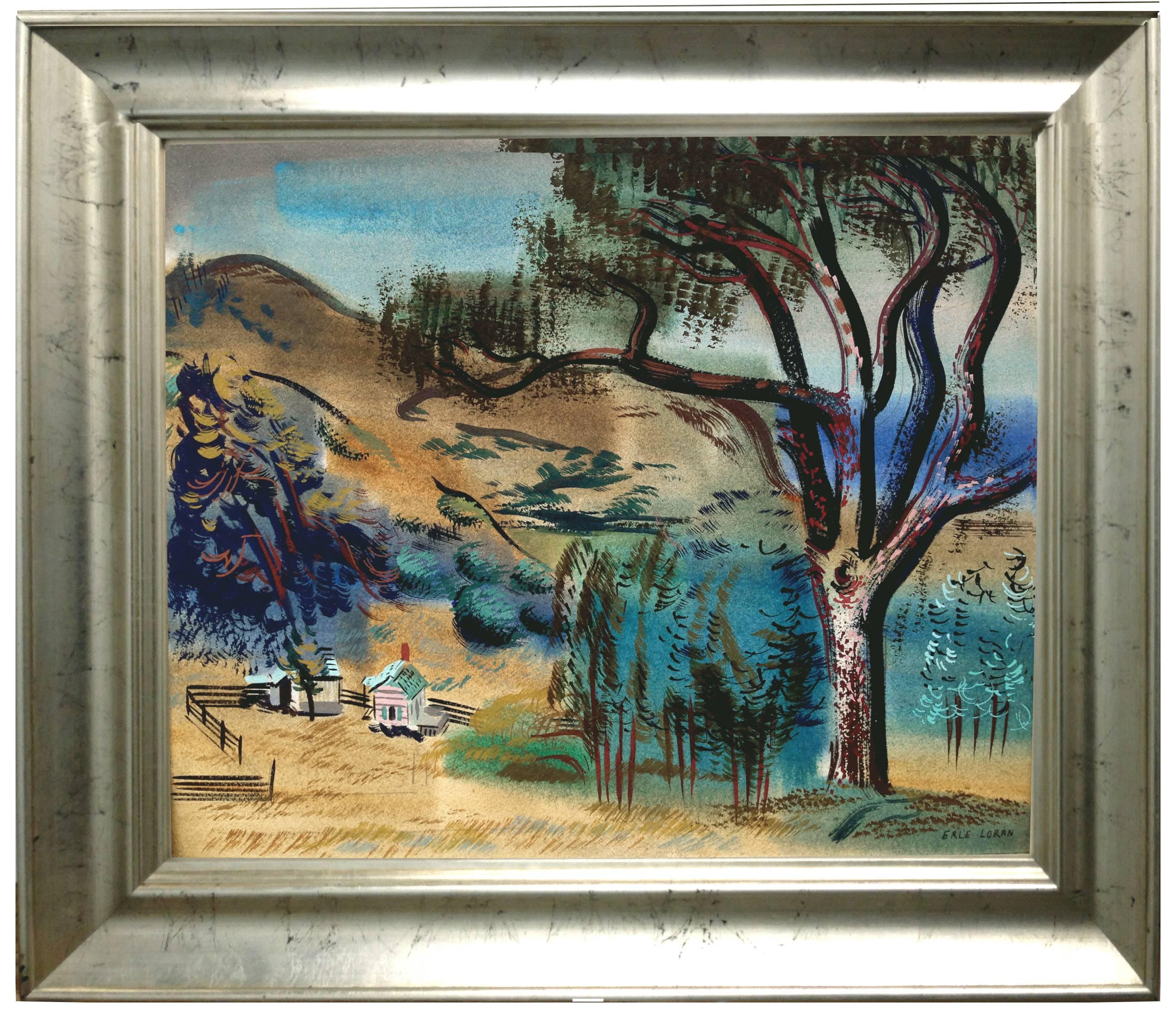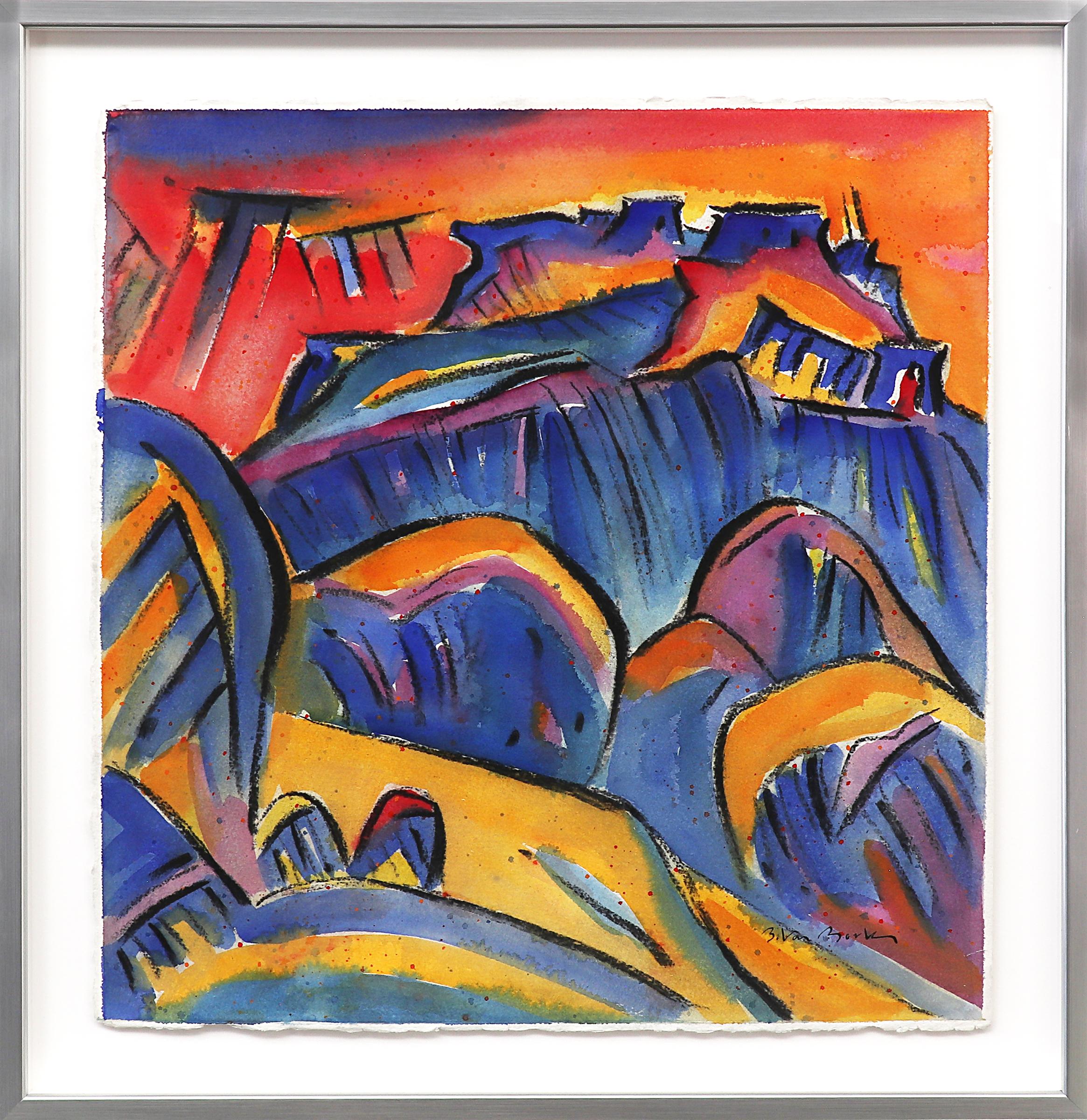Items Similar to “Rocky Mountain Meadow”
Want more images or videos?
Request additional images or videos from the seller
1 of 18
Werner Drewes“Rocky Mountain Meadow”1956
1956
About the Item
Original watercolor on archival paper of a Rocky Mountain Meadow by the well known American artist, Werner Drewes. Signed lower right. Titled and dated 1956 on verso of sheet. Condition is very good. Colors are bold and vivid. Sheet size is 20 by 27 inches. Sight size is 19.5 by 25.75 inches. Framed in its original cherry wood frame. Overall framed measurements are 26.5 by 32.5 inches. Under conservation glass. Provenance: Princeton Gallery of Fine Art, Princeton, New Jersey. See gallery label on backing in last photo.
Biography • Werner Drewes (1899-1985)
Werner Drewes was an artist fascinated with the formal possibilities of line, color and the potential of thematic motifs. Drewes was born in the village of Canig in eastern Germany. He began formal training in architecture and design in Stuttgart following his service in World War I. From 1921 to 1922 he studied at the Bauhaus at Weimar, where he was a pupil of Johannes Itten, Paul Klee and Oscar Schlemmer. Drewes then traveled extensively through Italy and Spain to study the Old Masters then set out to travel around the world. In 1927 Drewes returned to Germany and continued his studies at the Bauhaus, which had moved to Dessau, as a student of Wassily Kandinsky and Lyonel Feininger. He also attended Hinnerk Scheper's mural tutorials and Kandinsky's private painting classes. Drewes and Kandinsky became lifelong friends and both shared the belief that art could be a means towards understanding the larger philosophical issues of life. In 1930 he moved with his family to New York, where he continued his active career, striving to exhibit his work widely.
In 1931 Kandinsky introduced Drewes to Katherine Dreier, cofounder of the Société Anonyme. Drewes then had his first of several exhibitions with the Société Anonyme, of which he would later become the vice president. From 1934 to 1936 Drewes taught drawing and printmaking at the Brooklyn Museum School and from 1937 to 1940 he was an instructor of painting and printmaking at Columbia University. In 1936 he became a founding member of the American Abstract Artists and in 1937 he became an American citizen and joined the American Artists' Congress. He also served as director of the WPA Graphic Arts Division in New York City in 1940 and 1941.
In 1944 Drewes became a member of Stanley William Hayter's Atelier 17 in New York, where he produced experimental intaglio prints. He then taught this technique as an instructor of design and printmaking at Brooklyn College. In the summer of 1945 he became an instructor at Moholy-Nagy's Institute of Design, also known as the "New Bauhaus," in Chicago. In 1946 Drewes accepted the position of Professor of Design at the School of Fine Arts of Washington University in Saint Louis. Drewes continued to teach at Washington University until he retired in 1965. While there he became good friends with Max Beckmann who was also on the University's faculty. The University held an exhibition of Drewes's work in 1979.
Drewes maintained an energetic schedule of printmaking, painting, and exhibitions from the 1950s through the 1970s, and his output was prodigious. In 1969, the National Collection of Fine Arts in Washington used its substantial holding of the artist's work to circulate Four Decades of Woodcuts by Werner Drewes. The 36 prints on exhibit, most of them brightly colored, were chosen from some 300 in the museum's collection. His series of ten woodcuts entitled It Can't Happen Here rendered in 1934 are some of the earliest totally abstract prints made in this country. The National Museum of American Arts (previously the National Collection of Fine Art) held a retrospective of Drewes's work in 1984. Drewes died in Reston, Virginia in 1985.
The work of Werner Drewes can be found in many public collections, including: the Museum of Fine Arts, Boston, MA; the National Gallery of Art, Washington, D.C.; the Smithsonian American Art Museum, Washington, D.C.; and the Fine Arts Museums of San Francisco, CA.
- Creator:Werner Drewes (1899-1985, American)
- Creation Year:1956
- Dimensions:Height: 19.5 in (49.53 cm)Width: 25.75 in (65.41 cm)Depth: 1.5 in (3.81 cm)
- Medium:
- Movement & Style:
- Period:
- Condition:Possible foxing in several small spots in mountain. See last photo.
- Gallery Location:Southampton, NY
- Reference Number:1stDibs: LU14113157512
About the Seller
4.9
Platinum Seller
These expertly vetted sellers are 1stDibs' most experienced sellers and are rated highest by our customers.
Established in 1977
1stDibs seller since 2013
465 sales on 1stDibs
Typical response time: 1 hour
- ShippingRetrieving quote...Ships From: Southampton, NY
- Return PolicyA return for this item may be initiated within 7 days of delivery.
More From This SellerView All
- "The Winding Road"By John F. CarlsonLocated in Southampton, NYHere for your consideration is a very well executed pastel on paper by John Fabian Carlson. Signed lower right and mostly likely done in the 1930's...Category
1920s American Modern Landscape Drawings and Watercolors
MaterialsPaper, Oil Pastel
- “New England Homestead”Located in Southampton, NYVery well executed watercolor on archival paper of a New England homestead nestled in a picturesque valley. Early fall with the tress just starting to change colors. The watercolor was done by the American artist Hilton Leech...Category
1950s Modern Landscape Drawings and Watercolors
MaterialsWatercolor, Archival Paper, Graphite
- “Monhegan Island, Maine”By Ted DavisLocated in Southampton, NYOriginal watercolor of Monhegan Island, Maine on archival paper by the well known American watercolorist, Ted Davis. Signed lower right and dated 1950. Cond...Category
1950s Modern Landscape Drawings and Watercolors
MaterialsArchival Paper, Watercolor
- “Portland Harbor in 1910”Located in Southampton, NYBeautiful watercolor and gouache on archival paper by the well known Maine artist Bill Paxton. The watercolor depicts what Portland harbor in Maine looked like in 1910 with sailing vessels of the era moored in the harbor. Signed lower right by the artist. Titled verso. Circa 1975. Condition is excellent and is finely matted and framed. The artwork is matted and framed in a thin gold leaf custom gallery frame. Overall framed measurements are 17.5 by 21.75 inches. Provenance: Sarasota, Florida estate. William (Bill) Paxton 1930—2007 William Paxton, born August 5, 1930 in Lewiston, was one of Maine’s top selling artists. He had a passion for painting and from a young age he was known for his talents in sketching. Paxton captured many popular Maine scenes with watercolor, acrylic, and oils. His work also includes historical scenes he referenced in books from as early as the 1920’s, painting locomotives, aircraft, and war scenes. Paxton’s art is sold all over the world. As a student at Bridgton Academy, he was featured in his yearbook. It states, “When artist Bill picks up his pen, we all stand at attention, for his remarks and pictures are certainly worth mention.” He wanted to pursue a career selling his art, but it was during the time of the Great Depression. Also in his younger years, Paxton had an interest in skiing and won a medal for Second Highest Ski Jump. From there he went to flying and received a certification for Second-in-Command, to fly alongside the captain in a C-46F type of aircraft. He then joined the Air Force in the 40’s, although his passion and talents for art were constant throughout his life. Paxton quickly became the front line military sketch...Category
1970s Academic Landscape Drawings and Watercolors
MaterialsWatercolor, Gouache, Archival Paper
- “Gentle Seas”Located in Southampton, NYOriginal watercolor on arches paper in the post modernist style. Signed illegibly lower right. In excellent condition; newly matted with 1 inch natural oak frame with UV protective...Category
21st Century and Contemporary Post-Modern Landscape Drawings and Waterco...
MaterialsArchival Paper, Watercolor
- "Eglise Saint-Pierre”By Urbain HuchetLocated in Southampton, NYOriginal watercolor on archival paper of a Montmartre neighborhood by the well known French artist, Urbain Huchet. In the background is the Eglise Saint-Pierre or Church of Saint Peter. It is build on the original site of the Abbey of Montmartre built in the 12th century. Circa 1975. Signed lower left . In very good original to excellent condition. Framed in one inch wide mahogany frame. Overall measurements 20 by 23.5 inches. Urbain Huchet was born in Rennes on April 28, 1930. After studying law and owning a textile factory for four years, he decided in 1960 to devote himself entirely to painting. Mr. Huchet spent his first three years as an artist in Pont-Aven, following in the footsteps of Gauguin and Emile Bernard, both of whom influenced him a great deal. He does many paintings of the landscape and the typical people this region. His love of the Brittany coast and the sea can always be seen in his work. After moving to Paris in 1963, his love of adventure and travel led him to spend time painting and writing in Europe, the Middle East, and South America, where he produced many paintings of the Indian markets and the great scenery. He made 14 trips of more than 4 months each, from Mexico to Brazil via Peru, Central America and the Caribbean Islands. In addition to the paintings, he has written a book about these beautiful countries. A luxurious portfolio of paintings of Egypt...Category
1970s Post-Impressionist Landscape Drawings and Watercolors
MaterialsWatercolor, Archival Paper
You May Also Like
- Modernist Abstract Expressionist Watercolor Painting Bauhaus Weimar Pawel KontnyBy Pawel KontnyLocated in Surfside, FLAbstract watercolor composition bearing the influence of the earlier color-block compositions of Paul Klee. Pawel August Kontny, (Polish-German-American artist) He was born in Laurahuette, Poland, in 1923, the son of a wealthy pastry shop owner. In 1939 he began studying architecture in Breslau where he was introduced to the European masters and to the work of some of the German Expressionists, soon afterward banned as "degenerate artists" and removed from museums throughout Germany by the Nazi regime. His studies were interrupted by World War II. Drafted into the German army, traveling in many countries as a soldier, he sketched various landscapes but in 1945, he was captured and held as a prisoner of war in Italy. After the war, he studied at the Union of Nuremberg Architects to help design buildings to replace ones destroyed in the war. He recorded his impressions of the local population and the landscapes through his watercolors and drawings. Pawel Kontny thereafter moved to Nuremberg, Germany, becoming a member of the Union of Nuremberg Architects and helping to rebuild the city's historic center. He soon decided to concentrate on his professional art career. He married Irmgard Laurer, a dancer with the Nuremberg Opera. Pavel Kontny 's career as an artist was launched with his participation in an all German exhibition, held at the Dusseldorf Museum in 1952. He held one-man shows in Germany, Switzerland and the United States. During his trip to the United States in 1960, Kontny became instantly enamored with Colorado, and decided to relocate to Cherry Hills with his wife and two children. He quickly established himself in the local art community, being affiliated for a time with Denver Art Galleries and Saks Galleries. His subject matter became the Southwest. During this time he received the Prestigious Gold Medal of the Art Academy of Rome. His extensive travel provided material for the paintings he did using his hallmark marble dust technique. he also worked equally in pastel, watercolor, charcoal and pencil-and-ink. in a style which merged abstraction and realist styles, influenced by Abstract Expressionist painting and South Western American landscapes. This one bears the influence of Sam Francis. In the early 1960s he was one of only a few European-born professional artists in the state, a select group that included Herbert Bayer (1900-1985), a member of the prewar Bauhaus in Weimar and Dessau, Germany, and Roland Detre (1903-2001), a Hungarian modernist painter. As a Denver, Colorado resident, Pavel Kontny exhibited at galleries and museums throughout the United States, Germany and Japan. There, he was inspired by frequent trips to Native American pueblos in the Southwest, as well as by the study of the Plains Indians of Montana and Wyoming. Over the years Kontny had a number of students and generously helped young artist by hosting exhibitions at his Cherry Hills home. For many years he generously donated his paintings to support charitable causes in Denver. Influences during his European years included German pastelist C.O. Muller, German Informel painter Karl Dahmen and Swiss artist, Hans Erni. In the early 1950s his painting style showed the influence of the Die Brücke (The Bridge), a group of German expressionist artists formed in Dresden in 1905 who had a major impact on the evolution of modern art in the twentieth century in Germany. By the middle of the decade his style incorporated more referential abstraction and total abstraction, resulting in part from his study of Hans Hartung, a German artist based in Paris who exhibited his gestural abstract work in Germany. The American moon landing in 1969 inspired Paul Kontny...Category
20th Century American Modern Abstract Drawings and Watercolors
MaterialsWatercolor, Archival Paper
- Modernist Abstract Expressionist Watercolor Painting Bauhaus Weimar Pawel KontnyBy Pawel KontnyLocated in Surfside, FLAbstract watercolor composition bearing the influence of the earlier color-block compositions of Paul Klee. Pawel August Kontny, (Polish-German-American artist) He was born in Laurahuette, Poland, in 1923, the son of a wealthy pastry shop owner. In 1939 he began studying architecture in Breslau where he was introduced to the European masters and to the work of some of the German Expressionists, soon afterward banned as "degenerate artists" and removed from museums throughout Germany by the Nazi regime. His studies were interrupted by World War II. Drafted into the German army, traveling in many countries as a soldier, he sketched various landscapes but in 1945, he was captured and held as a prisoner of war in Italy. After the war, he studied at the Union of Nuremberg Architects to help design buildings to replace ones destroyed in the war. He recorded his impressions of the local population and the landscapes through his watercolors and drawings. Pawel Kontny thereafter moved to Nuremberg, Germany, becoming a member of the Union of Nuremberg Architects and helping to rebuild the city's historic center. He soon decided to concentrate on his professional art career. He married Irmgard Laurer, a dancer with the Nuremberg Opera. Pavel Kontny 's career as an artist was launched with his participation in an all German exhibition, held at the Dusseldorf Museum in 1952. He held one-man shows in Germany, Switzerland and the United States. During his trip to the United States in 1960, Kontny became instantly enamored with Colorado, and decided to relocate to Cherry Hills with his wife and two children. He quickly established himself in the local art community, being affiliated for a time with Denver Art Galleries and Saks Galleries. His subject matter became the Southwest. During this time he received the Prestigious Gold Medal of the Art Academy of Rome. His extensive travel provided material for the paintings he did using his hallmark marble dust technique. he also worked equally in pastel, watercolor, charcoal and pencil-and-ink. in a style which merged abstraction and realist styles, influenced by Abstract Expressionist painting and South Western American landscapes. This one bears the influence of Sam Francis. In the early 1960s he was one of only a few European-born professional artists in the state, a select group that included Herbert Bayer (1900-1985), a member of the prewar Bauhaus in Weimar and Dessau, Germany, and Roland Detre (1903-2001), a Hungarian modernist painter. As a Denver, Colorado resident, Pavel Kontny exhibited at galleries and museums throughout the United States, Germany and Japan. There, he was inspired by frequent trips to Native American pueblos in the Southwest, as well as by the study of the Plains Indians of Montana and Wyoming. Over the years Kontny had a number of students and generously helped young artist by hosting exhibitions at his Cherry Hills home. For many years he generously donated his paintings to support charitable causes in Denver. Influences during his European years included German pastelist C.O. Muller, German Informel painter Karl Dahmen and Swiss artist, Hans Erni. In the early 1950s his painting style showed the influence of the Die Brücke (The Bridge), a group of German expressionist artists formed in Dresden in 1905 who had a major impact on the evolution of modern art in the twentieth century in Germany. By the middle of the decade his style incorporated more referential abstraction and total abstraction, resulting in part from his study of Hans Hartung, a German artist based in Paris who exhibited his gestural abstract work in Germany. The American moon landing in 1969 inspired Paul Kontny...Category
20th Century American Modern Abstract Drawings and Watercolors
MaterialsWatercolor, Archival Paper
- Modernist Abstract Expressionist Watercolor Painting Bauhaus Weimar Pawel KontnyBy Pawel KontnyLocated in Surfside, FLAbstract watercolor composition bearing the influence of the earlier color-block compositions of Paul Klee. Pawel August Kontny, (Polish-German-American artist) He was born in Laurahuette, Poland, in 1923, the son of a wealthy pastry shop owner. In 1939 he began studying architecture in Breslau where he was introduced to the European masters and to the work of some of the German Expressionists, soon afterward banned as "degenerate artists" and removed from museums throughout Germany by the Nazi regime. His studies were interrupted by World War II. Drafted into the German army, traveling in many countries as a soldier, he sketched various landscapes but in 1945, he was captured and held as a prisoner of war in Italy. After the war, he studied at the Union of Nuremberg Architects to help design buildings to replace ones destroyed in the war. He recorded his impressions of the local population and the landscapes through his watercolors and drawings. Pawel Kontny thereafter moved to Nuremberg, Germany, becoming a member of the Union of Nuremberg Architects and helping to rebuild the city's historic center. He soon decided to concentrate on his professional art career. He married Irmgard Laurer, a dancer with the Nuremberg Opera. Pavel Kontny 's career as an artist was launched with his participation in an all German exhibition, held at the Dusseldorf Museum in 1952. He held one-man shows in Germany, Switzerland and the United States. During his trip to the United States in 1960, Kontny became instantly enamored with Colorado, and decided to relocate to Cherry Hills with his wife and two children. He quickly established himself in the local art community, being affiliated for a time with Denver Art Galleries and Saks Galleries. His subject matter became the Southwest. During this time he received the Prestigious Gold Medal of the Art Academy of Rome. His extensive travel provided material for the paintings he did using his hallmark marble dust technique. he also worked equally in pastel, watercolor, charcoal and pencil-and-ink. in a style which merged abstraction and realist styles, influenced by Abstract Expressionist painting and South Western American landscapes. This one bears the influence of Sam Francis. In the early 1960s he was one of only a few European-born professional artists in the state, a select group that included Herbert Bayer (1900-1985), a member of the prewar Bauhaus in Weimar and Dessau, Germany, and Roland Detre (1903-2001), a Hungarian modernist painter. As a Denver, Colorado resident, Pavel Kontny exhibited at galleries and museums throughout the United States, Germany and Japan. There, he was inspired by frequent trips to Native American pueblos in the Southwest, as well as by the study of the Plains Indians of Montana and Wyoming. Over the years Kontny had a number of students and generously helped young artist by hosting exhibitions at his Cherry Hills home. For many years he generously donated his paintings to support charitable causes in Denver. Influences during his European years included German pastelist C.O. Muller, German Informel painter Karl Dahmen and Swiss artist, Hans Erni. In the early 1950s his painting style showed the influence of the Die Brücke (The Bridge), a group of German expressionist artists formed in Dresden in 1905 who had a major impact on the evolution of modern art in the twentieth century in Germany. By the middle of the decade his style incorporated more referential abstraction and total abstraction, resulting in part from his study of Hans Hartung, a German artist based in Paris who exhibited his gestural abstract work in Germany. The American moon landing in 1969 inspired Paul Kontny...Category
20th Century American Modern Abstract Drawings and Watercolors
MaterialsWatercolor, Archival Paper
- 1940's California Hills LandscapeBy Erle LoranLocated in Soquel, CASubstantial and period mid-century modern American Scene watercolor of the Oakland, California countryside by Erle Loran (American, 1905-1999), 1944. Signed lower right "Earl Loran...Category
1940s American Modern Landscape Drawings and Watercolors
MaterialsWatercolor, Archival Paper
- Second Mesa (Hopi Pueblo, Arizona), Multicolored Southwest Mixed Media LandscapeLocated in Denver, CO'Second Mesa (Hopi Pueblo, Arizona)' is a watercolor, ink, and charcoal on paper by Bert Van Bork (1928-2014). Signed by the artist in the lower right co...Category
1980s American Modern Landscape Drawings and Watercolors
MaterialsCharcoal, Archival Ink, Watercolor, Archival Paper
- Modernist Trees, 1940s Framed Modernist Landscape Watercolor Painting, Red GreenBy Richard SorbyLocated in Denver, COModernist painting of trees, interior forest scene by Colorado artist, Richard Sorby (1911-2001). Painted in dark colors of green, blue and black with brown, orange and white. Water...Category
1940s American Modern Landscape Drawings and Watercolors
MaterialsWatercolor, Archival Paper
Recently Viewed
View AllMore Ways To Browse
Oscar Schlemmer
Saint Louis Colored
Korean Military Portrait
Byron Wolfe
Dorothy Southern
Gerard Martin
Naive Portrait Animal
C Barth
Immaculate Conception Oil Painting
Salad Days
Victor Wilde
Metal Highway Sign
Reclining Female Nude Ink
Four Palm Tree Prints
Naive Paintings Boat
New Wave Extra Large
Renee Hunter
African American Art Oil Vintage





